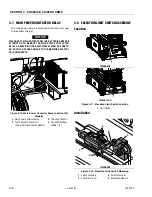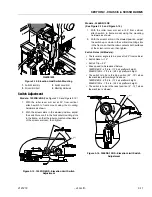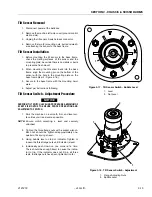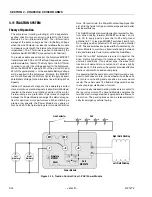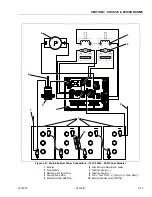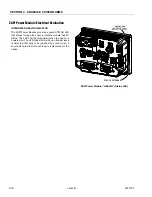
SECTION 3 - CHASSIS & SCISSOR ARMS
3121273
– JLG Lift –
3-5
Battery Charger Maintenance
USE CHARGER ONLY ON BATTERY SYSTEMS WITH AN ALGO-
RITHM SELECTED THAT IS APPROPRIATE TO THE SPECIFIC
BATTERY TYPE. OTHER USAGE MAY CAUSE PERSONAL INJURY
AND DAMAGE.
LEAD ACID BATTERIES MAY GENERATE EXPLOSIVE HYDRO-
GEN GAS DURING NORMAL OPERATION. KEEP SPARKS,
FLAMES, AND SMOKING MATERIALS AWAY FROM BATTERIES.
PROVIDE ADEQUATE VENTILATION DURING CHARGING. NEVER
CHARGE A FROZEN BATTERY.
STUDY ALL BATTERY MANUFACTURERS’ SPECIFIC PRECAU-
TIONS SUCH AS RECOMMENDED RATES OF CHARGE AND
REMOVING OR NOT REMOVING CELL CAPS WHILE CHARGING.
CAUTION
ONLY PLUG THE CHARGER INTO A PROPERLY INSTALLED AND
GROUNDED OUTLET. DO NOT USE GROUND ADAPTORS OR
MODIFY PLUG. DO NOT TOUCH NON-INSULATED PORTION OF
OUTPUT CONNECTOR OR NON-INSULATED BATTERY TERMI-
NAL.
DO NOT OPERATE CHARGER IF THE AC SUPPLY CORD IS DAM-
AGED OR IF THE CHARGER HAS RECEIVED A SHARP BLOW,
BEEN DROPPED, OR OTHERWISE DAMAGED IN ANY WAY.
ALWAYS DISCONNECT THE CHARGER AC SUPPLY BEFORE
MAKING OR BREAKING THE (POS/NEG) CONNECTIONS TO THE
BATTERY.
DO NOT OPEN OR DISASSEMBLE CHARGER.
1. For flooded lead-acid batteries, regularly check
water levels of each battery cell after charging and
add distilled water as required to level specified by
battery manufacturer. Follow the safety instructions
recommended by the battery manufacturer.
2. Make sure charger connections to battery terminals
are tight and clean.
3. Do not expose charger to oil or to direct heavy water
spraying when cleaning vehicle.
Battery Charger Troubleshooting
No Lights at all
No Lights at all indicate that AC power to the charger is
not connected or that the AC voltage is too low. It could
also indicate an internal failure in the charger.
1. Check the connections to AC power. Check for AC
voltage between 90 and 260 VAC at the charger.
2. If the AC voltage is verified to be correct at the con-
nection to the charger, and the charger still displays
no lights at all, return the charger for service.
FAULT LED Flashing
The Fault LED flashes to indicate the micro-controller
inside the battery charger has detected a fault. The fault
detected is indicated by the number of flashes. Count the
number of flashes to determine the fault.
With any battery system, the most common problem will
be a faulty battery connection. Because of the high likeli-
hood of a battery connection problem, it is always worth-
while to confirm that all connections are good before
checking for any other problems.
[1 Flash] - High Battery Voltage
1. Indicates a high battery voltage. Check that the bat-
tery charger voltage is consistent with the battery
pack voltage. The first two digits of the four digit
model name indicate the battery voltage the charger
supports.
2. Check for wiring errors.
3. This fault will automatically clear and the charger will
restart charging when this problem is removed.
4. High battery voltage could also occur if there is
another source charging the battery. Disconnect any
other sources during charging.
5. If this problem does not clear after the battery volt-
age is confirmed to be less than 2.4V per cell, return
the charger for service.
[2 Flashes] - Low Battery Voltage
1. Indicates either a battery failure, no battery con-
nected, or a lower than expected battery voltage.
Check the battery and battery connections.
2. Check the nominal battery voltage. The first two dig-
its of the four digit model name indicate the battery
voltage the charger supports. Confirm that a nomi-
nal battery voltage is the same as the charger volt-
age.
3. This fault will clear automatically when the low bat-
tery voltage problem is rectified.
Содержание 1932RS
Страница 1: ...Service Maintenance Manual Models 1932RS 6RS 3248RS 10RS 3121273 April 8 2013...
Страница 2: ......
Страница 12: ...viii JLG Lift 3121273 TABLE OF CONTENTS NOTES...
Страница 69: ...SECTION 3 CHASSIS SCISSOR ARMS 3121273 JLG Lift 3 37 NOTES...
Страница 73: ...SECTION 3 CHASSIS SCISSOR ARMS 3121273 JLG Lift 3 41 Figure 3 41 Arms and Platform Positioning and Support...




















